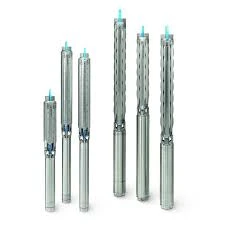Nov . 09, 2024 19:13 Back to list
Troubleshooting Issues with Submersible Water Pump Operating Ineffectively
Troubleshooting Submersible Water Pumps Common Issues and Solutions
Submersible water pumps are essential devices used in various applications, from residential drainage to agricultural irrigation. When these pumps fail to work, it can lead to significant inconvenience and potential property damage. Understanding the common reasons why a submersible water pump may not be functioning correctly is crucial for both homeowners and professionals alike.
Common Issues with Submersible Water Pumps
1. Power Supply Problems The first step in troubleshooting a malfunctioning submersible water pump is to check the power supply. Ensure that the pump is plugged in and that the outlet is functioning properly. You can do this by testing the outlet with another device or using a multimeter to check for voltage. If the pump is connected to a float switch, ensure that the switch is functioning and is not stuck in the off position.
2. Overheating Submersible pumps can overheat due to prolonged use, especially when operating in shallow water where the motor is not adequately cooled. Overheating can cause thermal overload protection to shut off the pump. Allow the pump to cool down and check for any obstructions that may have restricted water flow.
3. Clogged Filter or Impeller A clogged filter or impeller can prevent water from flowing through the pump efficiently. Debris such as dirt, sand, or even small rocks can accumulate and block the intake or impeller. To address this, turn off the power, remove the pump from the water, and clean the filter and impeller thoroughly. Make sure to reassemble the pump securely before testing it again.
4. Mechanical Seal Failure The mechanical seal in submersible pumps is designed to prevent water from entering the motor. If the seal has worn out or failed, it can result in water damage to the motor, leading to pump failure. In this case, you may need to replace the seal or, if the motor is damaged beyond repair, consider replacing the entire pump.
5. Incorrect Sizing Sometimes, the issue lies not with the pump itself but with its suitability for the specific application. If the pump is too small for the required flow rate or head height, it may struggle to perform effectively. Always consult the manufacturer’s specifications to ensure you have the right pump for your needs.
submersible water pump not working

Preventive Measures
To prevent future issues and extend the lifespan of your submersible water pump, consider implementing the following preventive measures
- Regular Maintenance Routine inspection and maintenance can catch potential issues before they become significant problems. Check the power supply, clean the impeller and intake regularly, and inspect the electrical connections.
- Use a Screen Installing a screen at the intake can prevent larger debris from entering the pump and clogging the impeller.
- Proper Installation Ensure the pump is installed at an appropriate depth in water and is not running dry. Pumps should always be submerged in liquid to prevent overheating.
- Monitor Water Levels If using a pump with a float switch, make sure the water levels are appropriate and that the switch is appropriately located to avoid constant on/off cycling of the pump.
Conclusion
When faced with a submersible water pump that is not working, it is essential to follow a systematic approach to troubleshoot and resolve the issue. By checking the power supply, addressing any clogs, ensuring the mechanical seal is intact, and utilizing regular maintenance practices, you can often restore your pump to full functionality. Understanding your pump’s operational needs and specifications will help prevent further issues and ensure it operates efficiently for years to come.
-
Submersible Water Pump: The Efficient 'Power Pioneer' of the Underwater World
NewsJul.01,2025
-
Submersible Pond Pump: The Hidden Guardian of Water Landscape Ecology
NewsJul.01,2025
-
Stainless Well Pump: A Reliable and Durable Pumping Main Force
NewsJul.01,2025
-
Stainless Steel Submersible Pump: An Efficient and Versatile Tool for Underwater Operations
NewsJul.01,2025
-
Deep Well Submersible Pump: An Efficient 'Sucker' of Groundwater Sources
NewsJul.01,2025
-
Deep Water Well Pump: An Efficient 'Sucker' of Groundwater Sources
NewsJul.01,2025
-
 Submersible Water Pump: The Efficient 'Power Pioneer' of the Underwater WorldIn the field of hydraulic equipment, the Submersible Water Pump has become the core equipment for underwater operations and water resource transportation due to its unique design and excellent performance.Detail
Submersible Water Pump: The Efficient 'Power Pioneer' of the Underwater WorldIn the field of hydraulic equipment, the Submersible Water Pump has become the core equipment for underwater operations and water resource transportation due to its unique design and excellent performance.Detail -
 Submersible Pond Pump: The Hidden Guardian of Water Landscape EcologyIn courtyard landscapes, ecological ponds, and even small-scale water conservancy projects, there is a silent yet indispensable equipment - the Submersible Pond Pump.Detail
Submersible Pond Pump: The Hidden Guardian of Water Landscape EcologyIn courtyard landscapes, ecological ponds, and even small-scale water conservancy projects, there is a silent yet indispensable equipment - the Submersible Pond Pump.Detail -
 Stainless Well Pump: A Reliable and Durable Pumping Main ForceIn the field of water resource transportation, Stainless Well Pump has become the core equipment for various pumping scenarios with its excellent performance and reliable quality.Detail
Stainless Well Pump: A Reliable and Durable Pumping Main ForceIn the field of water resource transportation, Stainless Well Pump has become the core equipment for various pumping scenarios with its excellent performance and reliable quality.Detail
